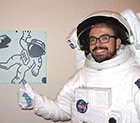
Explore the 2019 Pi Day Challenge.
Teachable Moment .
.4 min readNASA Rocket Science? It's Easy As Pi
Update: March 15, 2019 – The answers to the 2019 NASA Pi Day Challenge are here!
The excitement of Pi Day – and our annual excuse to chow down on pie – is upon us! The holiday celebrating the mathematical constant pi arrives on March 14, and with it comes the sixth installment of the NASA Pi Day Challenge from the Jet Propulsion Laboratory’s Education Office. This challenge gives students in grades 6-12 a chance to solve four real-world problems faced by NASA scientists and engineers. (Even if you’re done with school, they’re worth a try for the bragging rights.)
Why March 14?
Pi, the ratio of a circle’s circumference to its diameter, is what is known as an irrational number. As an irrational number, its decimal representation never ends, and it never repeats. Though it has been calculated to trillions of digits, we use far fewer at NASA. In fact, 3.14 is a good approximation, which is why March 14 (or 3/14 in U.S. month/day format) came to be the date that we celebrate this mathematical marvel.
The first-known Pi Day celebration occurred in 1988. In 2009, the U.S. House of Representatives passed a resolution designating March 14 as Pi Day and encouraging teachers and students to celebrate the day with activities that teach students about pi.
The 2019 Challenge
This year’s NASA Pi Day Challenge features four planetary puzzlers that show students how pi is used at the agency. The challenges involve weathering a Mars dust storm, sizing up a shrinking storm on Jupiter, estimating the water content of a rain cloud on Earth and blasting ice samples with lasers!
The Science Behind the Challenge

In late spring of 2018, a dust storm began stretching across Mars and eventually nearly blanketed the entire planet in thick dust. Darkness fell across Mars’ surface, blocking the vital sunlight that the solar-powered Opportunity rover needed to survive. It was the beginning of the end for the rover’s 15-year mission on Mars. At its height, the storm covered all but the peak of Olympus Mons, the largest known volcano in the solar system. In the Deadly Dust challenge, students must use pi to calculate what percentage of the Red Planet was covered by the dust storm.
The Terra satellite, orbiting Earth since 1999, uses the nine cameras on its Multi-Angle Imaging SpectroRadiometer, or MISR, instrument to provide scientists with unique views of Earth, returning data about atmospheric particles, land-surface features and clouds. Estimating the amount of water in a cloud, and the potential for rainfall, is serious business. Knowing how much rain may fall in a given area can help residents and first responders prepare for emergencies like flooding and mudslides. In Cloud Computing, students can use their knowledge of pi and geometric shapes to estimate the amount of water contained in a cloud.
Jupiter’s Great Red Spot, a giant storm that has been fascinating observers since the early 19th century, is shrinking. The storm has been continuously observed since the 1830s, but measurements from spacecraft like Voyager, the Hubble Space Telescope and Juno indicate the storm is getting smaller. How much smaller? In Storm Spotter, students can determine the answer to that very question faced by scientists.
Scientists studying ices found in space, such as comets, want to understand what they’re made of and how they interact and react with the environment around them. To see what molecules may form in space when a comet comes into contact with solar wind or sunlight, scientists place an ice sample in a vacuum and then expose it to electrons or ultraviolet photons. Scientists have analyzed samples in the lab and detected molecules that were later observed in space on comet 67P/Churyumov-Gerasimenko. To analyze the lab samples, an infrared laser is aimed at the ice, causing it to explode. But the ice will explode only if the laser is powerful enough. Scientist use pi to figure out how strong the laser needs to be to explode the sample – and students can do the same when they solve the Icy Intel challenge.
Teach It
Articles
Related Activities
Multimedia
Explore More
Facts and Figures
Missions and Instruments
Websites
About the Author

Lyle Tavernier
Educational Technology Specialist, NASA-JPL Education Office
Teachable Moment Last Updated: Oct. 11, 2024











